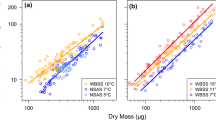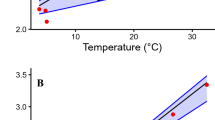Abstract
Sprat, Sprattus sprattus L., is a small schooling clupeid forming large stocks in several ecosystems. Despite its high trophodynamic impact, little is known about its energy consumption rates. As a central component of a bioenergetic budget, metabolic rates of sprat from 3.11 to 9.71 g wet weight (WW) were measured at nine different temperatures (T) ranging from 9 to 21°C using a computer-controlled intermittent-flow respirometer. Routine metabolism (R R) was related to T (°C) and WW (g) by R R = 0.074 WW1.077 e0.080 T. Standard metabolic rates (R S) as calculated from the 10% percentiles of the repeated measurements were on average 12% lower and still influenced by continuous swimming activity: R S = 0.069 WW1.073 e0.078 T. We interpret the deviation of the scaling exponent b from typically found exponents of b ~ 0.8 as a consequence of permanently elevated activity level. The high permanent swimming activities also indicated that the concept of standard metabolism may not be meaningful in schooling planktivorous fish. These results suggest that generally in bioenergetic models for clupeid schooling fish the activity multipliers should be chosen very conservatively.



Similar content being viewed by others
References
Armstrong JD, Priede IG, Lucas MC (1992) The link between respiratory capacity and changing metabolic demands during growth in northern pike, Esox lucius L. J Fish Biol 41(B):65–75
Arrhenius F (1993) Food consumption of larval, young and adult herring and sprat in the Baltic Sea. Mar Ecol Prog Ser 96:125–137
Arrhenius F (1996) Diet composition and food selectivity of 0-group herring (Clupea harengus L.) and sprat (Sprattus sprattus L.) in the northern Baltic Sea. ICES J Mar Sci 53:701–712
Arrhenius F (1998) Food intake and seasonal changes in energy content of young Baltic Sea sprat (Sprattus sprattus L.). ICES J Mar Sci 55:319–324
Arrhenius F, Hansson S (1993) Food consumption of larval, young and adult herring and sprat in the Baltic Sea. Mar Ecol Progr Ser 96:125–137
Bernreuther M (2007) Investigations on the feeding ecology of Baltic Sea herring (Clupea harengus L.) and sprat (Sprattus sprattus L.). PhD dissertation, University of Hamburg, Hamburg, Germany
Blaxter JHS (1989) Energy metabolism in animals and man. Cambridge University Press, Cambridge
Blaxter JHS, Hunter JR (1982) The biology of the clupeoid fishes. In: Blaxter JHS, Russel FS, Yonge M (eds) Advances in marine biology 20. Academic Press, New York, pp 1–223
Brett JR (1962) Some considerations in the study of respiratory metabolism in fish, particularly salmon. J Fish Res Board Can 19:1025–1038
Brett JR (1965) The relation of size to rate of oxygen consumption and sustained swimming speed of sockeye salmon (Oncorhynchus nerka). J Fish Res Board Can 22:1491–1501
Brett JR, Groves TDD (1979) Physiological energetics. In: Hoar WS, Randall DJ, Brett JR (eds) Fish physiology–bioenergetics and growth Vol VII. Academic Press, New York, pp 279–352
Brill RW (1979) The effect of body size on the standard metabolic rate of skipjack tuna, Katsuwonus pelamis. Fish Bull 77:494–498
Brill RW (1987) On the standard metabolic rates of tropical tunas, including the effect of body size and acute temperature change. Fish Bull 85:25–34
Chekunova VI (1979) Energy requirements of the Baltic herring, Clupea harengus membras. J Ichthyol 19:118–125
Chekunova VI, Naumov AG (1977) Energy metabolism of the Falkland sprat, Sprattus fuegensis (in Russian). Voprosy Ikhtiol 17:338–344
Childress JJ, Somero GN (1990) Metabolic scaling: a new perspective based on scaling of glycolytic enzyme activities. Am Zool 30:161–173
Clarke A, Johnston N (1999) Scaling of metabolic rate with body mass and temperature in teleost fish. J Anim Ecol 68:893–905
Da Villa GJ (1983) Bacterial growth and antibiotics in animal respirometry. In: Gnaiger E, Forstner H (eds) Polarographic oxygen sensors—aquatic and physiological applications. Springer, Berlin, pp 202–218
Durbin GA, Durbin EG, Verity PG, Smayda TJ (1981) Voluntary swimming speeds and respiration rates of a filter-feeding planktivore, the Atlantic menhaden, Brevoortia tyrannus (Pisces: Clupeidae). Fish Bul 78:877–886
Enders EC, Herrmann JP (2003) Energy costs of spontaneous activity in horse mackerel quantified by a computerised imaging analysis. Arch Fish Mar Res 50:205–219
Fishbase (2009) Froese R, Pauly D (eds) World wide web electronic publication, http://www.fishbase.org, version (09/2009)
Forstner H (1983) An automated multiple-chamber intermittent-flow respirometer. In: Gnaiger E, Forstner H (eds) Polarographic oxygen sensors: aquatic and physiological applications. Springer, Berlin, pp 111–126
Fry FEJ (1947) Effects of the environment on animal activity. Univ Toronto Studies Biol Ser 55, Publ Fish Res Lab 68:1–62
Fry FEJ (1957) Aquatic respiration of fish. In: Brown ME (ed) The physiology of fishes. Academic press, New York, pp 1–63
Fry FEJ (1971) The effect of environmental factors on the physiology of fish. In: Hoar WS, Randall DJ (eds) Fish physiology vol VI. Academic Press, New York, pp 1–98
Glazier DS (2005) Beyond the ‘3/4-power law’: variation in the intra- and interspecific scaling of metabolic rate in animals. Biol Rev 80:611–662
Glazier DS (2009) Activity effects intraspecific body-size scaling of metabolic rate in ectothermic animals. J Comp Physiol B 179:821–828
Gooding RM, Neill WH, Dizon AE (1981) Respiration rates and low-oxygen tolerance limits in skipjack tuna, Katsuwonus pelamis. Fish Bul US 79:31–48
Herrmann JP, Enders EC (2000) Effect of body size on the standard metabolism of horse mackerel. J Fish Biol 57:746–760
Hettler WF (1976) Influence of temperature and salinity on routine metabolic rate and growth of young Atlantic menhaden. J Fish Biol 8:55–65
Hewett SW, Johnson BL (1992) Fish bioenergetics model 2: an update of a generalized bioenergetics model of fish growth for microcomputers. University of Wisconsin Sea Grant Institute, WIS-SG-91-250
James AG, Probyn T (1989) The relationship between respiration rate, swimming speed and feeding behaviour in the Cape anchovy Engraulis capensis Gilchrist. J Exp Mar Biol Ecol 131:81–100
Jobling M (1982) A study of some factors affecting rates of oxygen consumption of plaice, Pleuronectes platessa L. J Fish Biol 20:501–516
Jobling M (1994) Fish bioenergetics. Chapman and Hall, London
Johnstone ADF, Wardle CS, Almatar SM (1993) Routine respiration rates of Atlantic mackerel, Scomber scombrus L., and herring, Clupea harengus L., at low activity levels. J Fish Biol 42:149–151
Kitchell JF, Stewart DJ, Weininger D (1977) Applications of a bioenergetics model to yellow perch (Perca flavescens) and walleye (Stizostedion vitreum vitreum). J Fish Res Board Can 34:1922–1935
Köster FW, Möllmann C (2000) Trophodynamic control by clupeid predators on recruitment success in Baltic cod? ICES J mar Sci 57:310–323
Köster FW, Schober W, Korves A, Schneider R (1990) Tank experiments on board: a useful tool for the estimation of stomach evacuation rates? ICESCM 1990/G: 34. International Council for Exploration of the Seas, Copenhagen, Denmark
Köster FW, Hinrichsen H-H, St John MA, Schnack D, MacKenzie BR, Tomkiewicz J, Plikshs M (2001) Developing Baltic cod recruitment models. II. Incorporation of environmental variability and species interaction. Can J Fish Aquat Sci 58:1534–1556
Leonard JBK, Norieka JF, Kynard B, McCormick SD (1999) Metabolic rates in an anadromous clupeid, the American shad (Alosa sapidissima). J Comp Physiol B 169:287–295
Macy WK, Durbin AG, Durbin EG (1999) Metabolic rate in relation to temperature and swimming speed, and the cost of filter feeding in Atlantic menhaden, Brevoortia tyrannus. Fish Bull 97:282–293
Möllmann C, Müller-Karulis B, Kornilovs G, St. John MA (2008) Effects of climate and overfishing on zooplankton dynamics and ecosystem structure: regime shifts, trophic cascade, and feedback loops in a simple ecosystem. ICES J Mar Sci 65:302–310
Motulsky HJ, Christopoulos A (2004) Fitting models to biological data using linear and nonlinear regression. A practical guide to curve fitting. Oxford University Press, New York
Ohlberger J, Staaks G, Hölker F (2007) Effects of temperature, swimming speed and body mass on standard and active metabolic rate in vendace (Coregonus abula). J Comp Physiol B 177:905–916
Ohlberger J, Mehner T, Staaks G, Hölker F (2008) Temperature-related physiological adaptations promote ecological divergence in a sympatric species pair of temperate freshwater fish, Coregonus spp. Func Ecol 22:501–508
Peck MA, Clemmesen C, Herrmann J-P (2005) Ontogenetic changes in allometric scaling of the mass and length relationship in Sprattus sprattus. J Fish Biol 66:882–887
Permanne R, Rechlin O, Sjöstrand B (1994) Status and future of herring and sprat stocks in the Baltic Sea. Dana 10:29–59
Post JR, Lee JA (1996) Metabolic ontogeny in teleost fishes. Can J Fish Aquat Sci 53:910–923
Riisgard HU (1998) No foundation of “3/4 power scaling law” for respiration in biology. Ecol Lett 1:71–73
Rudstam LG (1988) Exploring the dynamics of herring consumption in the Baltic: applications of an energetic model of fish growth. Kiel Meeresforsch Sonderh 6:312–322
Schleuter D, Haertel-Borer S, Fischer P, Eckmann R (2007) Respiration rates of Eurasian perch Perca fluviatilis and ruffe: lower energy costs in groups. Trans Am Fish Soc 136:43–55
Somero GN, Childress JJ (1990) Scaling of ATP-supplying enzymes, myofibrillar proteins and buffering capacity in fish muscle: relationship to locomotory habit. J Exp Biol 149:319–333
Steffensen JF (1989) Some errors in respirometry of aquatic breathers: how to avoid and correct them. Fish Physiol Biochem 6:49–59
Steffensen JF, Bushnell PG, Schurmann H (1994) Oxygen consumption in four species of teleosts from Greenland: no evidence of metabolic cold adaptation. Polar Biol 14:49–54
Stolbov AY (1992) Energy metabolism of Sprattus sprattus phalericus Risso (in Russian). Ehkol Morya 41:63–65
van der Lingen CD (1995) Respiration rates of adult pilchard Sardinops sagax in relation to temperature, voluntary swimming speed and feeding behaviour. Mar Ecol Progr Ser 129:41–54
Villavicencio Z (1981) Investigacion respiromete de los requerimientos energeticos de anchoveta adulta (metabolismo estandar y actividad). Bol Inst Mar Peru extraordinario:193–205
Villavicencio Z, Lazo F, Contreras G (1981) Estudio del metabolismo estandar, requerimiento total de energia y actividad en juveniles de sardina (Sardinops sagax). Bol Inst Mar Peru extraordinario:206–214
Waller U (1986) Der Einfluß von Alter und Umwelt auf den Stoffwechsel des Steinbutt, Scophthalmus maximus, und Gesichtspunkte zu seiner Aufzucht und Haltung in der Aquakultur. PhD thesis, University Kiel, Kiel, Germany
Ware DM (1978) Bioenergetics of pelagic fish: theoretical change in swimming speed and ration with body size. J Fish Res Board Can 34:220–228
Wieser W (1985) Developmental and metabolic constrains of the scope for activity in young rainbow trout (Salmos gairdneri). J Exp Biol 118:133–142
Winberg GG (1960) Rate of metabolism and food requirements of fishes. Translation edited by FEJ Fry and WE Ricker. J Fish Res Board Can Transl Ser 194, 253 pp
Acknowledgments
We thank S. Stäcker for his assistance with all experiments and the maintenance of fish in the aquarium. We also like to thank M.A. Peck for his comments on earlier versions of the manuscript. Two anonymous referees provided helpful comments that improved the manuscript.
Author information
Authors and Affiliations
Corresponding author
Additional information
Communicated by C. Harrod.
Rights and permissions
About this article
Cite this article
Meskendahl, L., Herrmann, JP. & Temming, A. Effects of temperature and body mass on metabolic rates of sprat, Sprattus sprattus L.. Mar Biol 157, 1917–1927 (2010). https://doi.org/10.1007/s00227-010-1461-1
Received:
Accepted:
Published:
Issue Date:
DOI: https://doi.org/10.1007/s00227-010-1461-1




